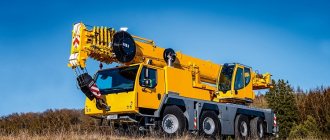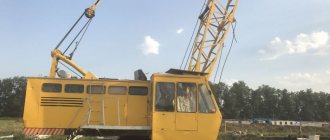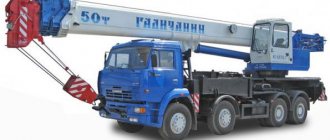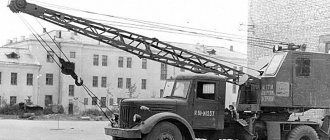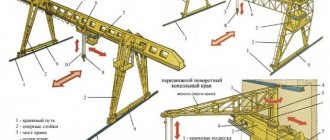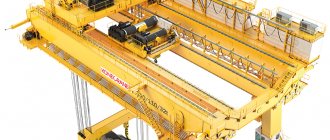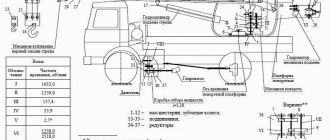Features of the Sokol portal crane and its technical characteristics
Let's take a closer look at the Sokol portal crane: its technical characteristics, drawings and price.
This special equipment is the development of the German concern Kranbau Eberwalde. The installation was a unique solution. It functioned successfully for several decades, but never failed its owners, it turned out to be so reliable. Due to the availability of various attachments, this gantry equipment is used in many industries. It is convenient for loading operations and successfully moves port containers. When attached, the hook is used for handling piece objects. If you attach a grab to the installation, you can move bulk products, and when you attach an electromagnet, you can move rolled metal.
Design features
Special equipment Sokol is an all-wheel drive portal installation with electric traction. It has a well-thought-out block design in the form of a column that can rotate, equipped with a boom on movable hinges. It is thanks to this design that the horizontal movement of the object is ensured simultaneously with a change in reach.
The unit is controlled by an operator from a comfortable cabin using an autonomous rotating device. Reviews from crane operators about it are the most positive. It allows the attachment to be rotated at right angles.
The equipment has 4 mobile carts for moving along rails. The turning part includes:
- Columns equipped with mechanisms.
- Fixed ballast.
- Controls in the operator's cab.
- The area from which the angle of rotation of the traverse changes.
- The zone from which the arrow's departure angle is changed.
- trunk connected by hinges;
- rigid guy;
- sliding counterweight and rocker arms with additional jibs.
It is the jib that contains a device that reduces wind loads on the attached grab. The installation is also equipped with a drum on which a cable is wound, including a load mechanism.
The machine area of the crane contains:
- Lifting mechanism.
- A system of switchboards with electrical equipment.
A turning mechanism is installed near the base of the column.
Control circuit
Controls for primary and secondary systems are located in the cab, making the operator's work easier. The general power supply of the systems is started by turning on the main machine; a separate button is provided to check the functionality of the control electrical circuits.
The load-handling mechanisms are controlled by controllers with an asymmetrical circuit and a pedal-type switch. The differential is connected to the grab bucket winch. This element ensures that the electric motor is turned off when raising and lowering the mechanism after opening the bucket.
Operations for lifting and lowering the load are performed by moving the controller levers to the final position. The intermediate position of the joystick is responsible for moving the load grippers over short distances at low speeds.
When lowering the load, the intermediate position of the controller acts as a single-phase brake.
To close the grab after scooping the load, two control methods are used:
- The pedal is pressed and both controllers move to the extreme position. In this situation, immediately after the bucket jaws close, lifting begins automatically. When the grab crawls up, the pedal is released.
- One of the controller handles is moved to the working position. This is a mechanical mode, and to raise the bucket you need to move the second joystick, aligning it with the first.
Advantages
The advantages of the Sokol portal installation lie in its lifting capabilities and precise adjustment of movement provided by control rollers. This technology makes it possible to reduce the load on crane tracks, reduce wear on mechanisms, and save spare parts. There are also other advantages:
- High accuracy can be achieved through the use of the method of horizontal movement of the object on the boom, which eliminates its swinging.
- The electrical equipment supplies a 380 V network through a cable that meets safety criteria and guarantees the functionality of the crane. Its length does not at all hinder the movement of the lifting unit. The remote control option on modern modifications of installations is provided by a GSM modem.
The price of the mechanisms directly depends on the lifting capacity of the crane. For a completely new unit you need to pay considerable sums - 7–23 million rubles.
To ensure uninterrupted operation of portal equipment, its timely maintenance and replacement of worn-out elements are required. It is imperative to use only original spare parts; many companies that cooperate directly with the manufacturer of the installations offer to buy them.
Type KPL-5-30, project 81040 Floating crane lifting capacity 5 t
Vessel type: full-revolving diesel-electric non-self-propelled floating crane. Crane type: full-rotary grab. Purpose of the vessel: carrying out transshipment operations. Place of construction: (Russia, Bor); Akhtubinsky Shipyard (Russia, Akhtubinsk). Register Class: "*O"
Characteristics:
Overall length (boom in stowed position): 45.1 m Design length: 28.6 m Width: 12 m Side height: 2.6 m Overall height (boom in stowed position): 10 m Average draft when loaded: 1.14 m Loaded displacement: 349.7 t Number of crew seats: 9 people Autonomy: 20 days Main diesel generator power: 330 l. With. (224 kW) Brand of main diesel generator: DGR224/750 (diesel 6Ch23/30, generator MCC375/280-750) Power of auxiliary diesel generator: 80 l. With. (58.8 kW) Auxiliary diesel generator brand: DGA50M1-9 (diesel 6Ch12/14, generator MSK83-4)
Portal crane GANZ (Gantz) - “an old friend is more reliable than the new two”
A gantry crane is a lifting device that is used in shipbuilding, ports and warehouses. It is difficult to replace in the construction industry and when performing installation and assembly work in workshops.
Types of gantry cranes
All portal mechanisms can be divided into two types: coastal and floating.
The first are those installations that operate on land. At the same time, their location does not matter, because they can be on the docks, in a port or at a factory that repairs ships. Such systems have a large load capacity; they are designed to move loads weighing more than 300 tons.
Floating installations are located on the water. They look like a vessel on which a mechanism for lifting cargo is installed. Installations are required to eliminate accidents and perform repair work. They are used not only on the water, but also near the shore.
Portal cranes of both types are needed not only for loading, but also for unloading, when it is necessary to move heavy loads from place to place.
The lifting unit has a boom. This is the name given to the part that can rotate from side to side, providing the operator with access to loads. Coastal cranes are able to move along railway rails; they are laid on the ground or on an overpass.
Classification of portal cranes by purpose
There is also a classification of portal cranes according to their purpose. Conventionally, all lifting installations can be divided into installation and reloading.
The first are divided into the following types: shipbuilding and construction purposes.
Reloading cranes are port cranes; they are designed to carry heavy loads weighing from 1.5 to 20 tons. They are practically indispensable when performing loading and unloading operations.
Installations that can carry loads of 3 tons or more are usually equipped with grabs. With their help you can work with bulk materials.
The lifting mechanisms are also equipped with hooks, which makes it possible to carry containers.
Installations with a lifting capacity of up to 3 tons are not equipped with grabs. They are used to supply floating river transport with coal. Such mechanisms only have hooks.
What kind of gantry crane is needed in a seaport?
If a lifting system is needed to operate in a seaport, it is worth installing a grab crane. It will move loads weighing up to 25 tons. For example, the Stork is often used to carry cargo. This is a multifunctional grab device that runs on electricity.
When choosing a crane for a port, you should pay attention to the maximum reach; it can be within 15-40 meters. Most often, a mechanism with a boom reach of 30 meters is used.
An important parameter is the track width. It depends on the number of railway tracks that are covered by the portal. Ports try to install systems that have a constant load capacity on all flights.
Type KPL 5-30, project 528, 528B Floating crane lift capacity 5 t
Vessel type: full-revolving diesel-electric non-self-propelled floating crane. Crane type: full-rotary grab electric. Purpose of the vessel: loading and unloading operations. Place of construction: (Russia, Bor); Register Class: "*P"
Characteristics:
Project 528 / 528B Overall length (boom in stowed position): 38.5 m Estimated length: 24.7 / 24.8 m Width: 12.1 m Side height: 2.5 m Overall height (boom in stowed position): 8.93 m Average draft when loaded: 0.87 m Displacement when loaded: 221.4 t Number of seats for crew: 11/8 people Autonomy: 15 days Main diesel generator power: 300 l. With. Brand of main diesel generator: DG200/1 (U08) (diesel 7D12, generator MS128-4) or U18GS-2k (diesel 1D12B-2k, generator GS104-4) Power of auxiliary diesel generator: 20 l. With. Auxiliary diesel generator brand: DG12/1-1 (diesel 2Ch10.5/13-2, generator MSA72-4A)
Types of gantry cranes
All portal mechanisms can be divided into the following types:
The first are those installations that operate on land.
At the same time, their location does not matter, because they can be on the docks, in a port or at a factory that repairs ships.
Such systems have a large load capacity and are designed to move heavy loads. Their weight often reaches 300 tons.
Floating installations are located on the water. They look like a vessel on which a mechanism for lifting cargo is installed. Installations are required to eliminate accidents and perform repair work. They are used not only on the water, but also near the shore.
Mechanisms are needed for loading, as well as for unloading, when it is necessary to move weights from place to place.
The installation has a boom, the crane is located on the portal. This is the name given to the part that can rotate from side to side, providing the operator with access to loads. Coastal cranes are able to move along railway rails; they are laid on the ground or on an overpass.
There is a classification of portal cranes according to their purpose; all installations can be divided into installation and reloading. The first are divided into the following:
- shipbuilding;
- construction purposes.
Reloading cranes are port cranes; they are designed to carry heavy loads weighing from 1.5 to 20 tons. They are indispensable when performing loading operations.
Installations that can carry loads of 3 tons or more are equipped with grabs. With their help you can work with bulk materials. The lifting mechanisms are also equipped with hooks, which makes it possible to carry containers.
Installations with a lifting capacity of up to 3 tons are not equipped with grabs. They are used to supply floating river transport with coal. Such mechanisms have hooks.
If a lifting system is needed to operate in a seaport, it is worth installing a grab crane. It will move loads weighing up to 25 tons. For example, the Stork is often used to carry loads. This is a multifunctional grab device that runs on electricity.
When choosing a crane for a port, you should pay attention to the maximum reach; it can be within 15-40 m. Most often, a mechanism with a boom reach of 30 m is used.
An important parameter is the track width. It depends on the number of railway tracks that are covered by the portal. Ports try to install systems that have a constant load capacity on all flights.
Portals can be of the following types:
If the need arises, they can be replaced with L-shaped half-portals. They differ in that one side of the horizontal frame rests on the running trolleys. They move along crane rails, which are laid on overpasses or on supporting structures of border warehouses.
River ports often have sloping embankments. In this case, the half-portals can move along rails that are laid on several levels. This is done to ensure that the crane's axis of rotation is as close as possible to the vessel that requires unloading.
During floods, the water level rises, flooding the railway track, but this does not interfere with the operation of the running trolleys. They move along the bottom rail, working underwater.
The design of a three-way crane is complex, but it can serve a large area. The construction of crane runways is expensive, so before installing loading cranes, it is necessary to take into account the payback period of the project.
The second large group includes assembly cranes used in the shipbuilding industry. They are required to perform ship repair work; they are also used to move piece cargo.
High portals are used to accommodate lifting installations; this improves the quality of ship maintenance during repairs.
Cranes are needed when building ships afloat; they are called outfitting cranes. Necessary if it is necessary to repair the vessel in dry docks. Such systems can often be found at repair embankments.
Cranes can be called slipway cranes. These lifting installations are used when ship hulls are assembled on slipways.
Assembly is carried out by units that have a lot of weight. This had an impact on the load-carrying capacity of the systems. Outfitting and slipway devices move loads weighing up to 80 tons. There are mechanisms that are capable of carrying heavier loads from place to place.
Assembly cranes lift the hook to a height of 50 m; they move a load weighing from 20 tons. The mechanisms have not only a main hook, but also an additional one. The load capacity of systems is variable and often depends on the reach. The load moves at low speed; this distinguishes cranes of this type from reloading cranes. The maximum boom reach is 35-40 m. For example, in the ports you can see the Abus and Albrecht cranes, which were produced in the GDR.
Separately, dock cranes can be distinguished; they move at low speed. They are only used inside the docks.
Device and purpose
The design of such a crane includes a crew room, systems for servicing the device, and deck components. Such a unit can receive power from the shore or be supplied with energy from its own engine.
The device is equipped with propellers and propeller impellers that move the structure forward, backward and sideways.
According to the rules of the Maritime Register, the units are equipped with units that are installed on ships. This includes bars, spiers for lifting the anchor, various loads, a winch, an anchor, an alarm system, a radio communication device and rescue equipment.
Before starting work, you need to prepare a supply of food, fresh water, and fuel for the engine for the period of voyage. Pontoons must be durable and buoyant. During transportation, the height of the structure is determined taking into account the height of the bridges and the ability to move under obstacles. Reloading cranes are used to unload ships and unload materials onto other ships.
Common gantry cranes
Enterprises widely use portal lifting mechanisms. When choosing an installation for an enterprise, you should pay attention to the most common models.
Falcon
The Sokol crane runs on electricity and has 4 supports. The mechanism has good technical characteristics. It is all-wheel drive and has a block design. The boom is made in such a way that the load moves horizontally. The rotating device is controlled from the cab, thanks to which the grab can be rotated 90°.
The mechanism operates from 380 V. The cables are of sufficient length, so the maneuverability of the equipment is not limited. It is designed in such a way that the load on the crane tracks is reduced. Parts wear out less.
Albatross
The Albatross crane allows the operator to move loads with high precision. This model was first released in the 70s of the 20th century. Today it can be found in ports and industrial sites.
It is equipped with a hook, but in operation an electromagnetic grip is often used. It is possible to use a grab. A special feature of the lifting mechanism is that it moves the load in a horizontal plane.
The device is used to work with bulk cargo; it can be used to move piece objects.
Kirovets
This model was first released 50 years ago and today there are more than 2,500 units in use. In the modifications produced by the enterprises, new electric motors and gearboxes are installed. The advantage of purchasing such models is that they do not require high operating costs.
The Ganz gantry crane is characterized by high efficiency. The operator can use a grab or a hook. This is a reliable installation equipped with a recovery system. The service life of the mechanism is long, which is why many enterprises purchase it.
Condor
The Condor crane is reliable. A magnet and a grab are used to move goods; a spreader is often used.
The mechanism can be equipped with a hook. It moves loads from 16 to 40 tons. The models that manufacturers produce now can move weights weighing up to 120 tons.
Knight
The Vityaz crane is a lifting equipment that can carry loads of up to 200 tons with a hook. In grab mode, the hoisting and transport machine carries up to 60 tons. The boom has a long reach, it reaches 60 m.
KP-640
The portal crane KP-640 lifted up to 640 tons. It is equipped with 2 cranes capable of lifting 320 tons.
General technical description
The Ganz crane is universal, so it can work with a hook and a grab. In the first case, the nominal load capacity is 32 tons, in the second - 16 tons. A model is produced on 4 supports, which provides increased stability, and is a double-track type. The moving part of the crane is represented by 3-wheeled trolleys, two of which are equipped with a drive. Balancing of this unit is ensured by a vertically located hinge. The power unit of the driving bogies is articulated with a bevel-cylindrical gearbox. Stopping is accomplished by a two-block brake. The electric motor and braking system are attached to the gearbox, which is integrated with the roller frame.
The portal is fully rotatable, with a rotation radius of 360 degrees. Thanks to the proper location and panoramic glazing of the cabin, excellent visibility is achieved, which has a positive effect on the convenience and safety of work.
The electric drive deserves special attention. The load-lifting structural elements and chassis are equipped with two electric motors. The rotary device and the boom extension control unit each have one electric motor. The power plants are powered from a three-phase alternating current network with a voltage of 380 V. Starting is carried out using electromagnetic controllers; an additional differential device is provided for automatic operation of the grab.
The electrical circuit of the portal crane provides individual protection for each motor in case of significant voltage drops in the network or short circuit. Due to the use of a system for recovering unspent electricity, the energy efficiency of Ganz cranes is higher than that of analogues. In addition, limit switches are mounted on the lifting mechanisms and the boom extension block, interrupting the movement of the controlled element in two directions. If the heater of one electric drive is triggered, the remaining components of the portal crane continue to function normally.
The crane is built according to a design that simplifies installation and dismantling of equipment. The main components and mechanisms have a high working life, and if you follow all the requirements for maintenance and repair specified in the operating instructions, the likelihood of sudden breakdowns and unplanned downtime of the crane is reduced to zero.
Prices and reviews
The cost of the mechanisms depends on their carrying capacity; for new equipment you will have to pay from 7 to 230 thousand rubles.
Alexey, 54 years old, Kaluga
I needed a tower crane for work, we bought a used one and didn’t regret it. It works properly, only scheduled repairs were carried out. Everyone is happy.
Oleg, 28 years old, Samara I work as a crane operator, installing portal cranes. I will say that the mechanisms are reliable. You can work with bulk cargo and move heavy loads with a hook. Convenient for the enterprise.
Stanislav, 52 years old, Yakutsk
Vityaz, Sokol and Ganz are reliable mechanisms. They are indispensable in the port. You just need to carefully read the instruction manual and know how to work, then there will be no emergency. Such units are installed by specialists, so they last a long time.
Scope of application
Depending on the design features and type of load-handling device, the Condor portal crane can work in river and sea ports with various types of cargo: piece, bulk, containers, etc.
Despite the high quality, any equipment fails over time and requires replacement of components. specializes in sales of original spare parts and offers a wide range of main parts and assemblies for Condor portal cranes.
Portal crane Kirovets KPP 16/20
Specifications:
load capacity - 16/20 tons; load lifting height - 26.5 m; lifting speed - 66 m/min; boom radius - 32 m; speed of change of full boom extension – 0.42 min; movement speed – 33 m/min; rotation speed – 1.5 rpm; wheel pressure on rail – 31.5 tons; track - 10.5 m; weight – 235 tons; permissible wind load – 20 kg/sq.m. meter.
TSFUR system Chair-remote input cabinet Lifting 2 x 75 kW Boom radius 1 x 30 kW Swinging 1 x 45 kW
Description of the Kirovets portal crane:
The Kirovets portal crane with a lifting capacity (lifting capacity) of 16 tons in grab and 20 tons in hook modes, respectively, was designed and built in Leningrad in 1983. Along with Sokol, Albatross and Condor cranes, lifting machines of this type are widely used in Russian ports.
Portal reloading electric mobile full-rotating crane KPP 16(20) Kirovets with an articulated boom ensures almost horizontal movement of the load when the reach changes.
The crane is designed for reloading piece and bulk cargo at industrial enterprises. It consists of a portal mounted on 4 running trolleys and a rotating part. The double-track portal has a distance between the axes of 10.5 m. Each of the running trolleys has its own drive and is equipped with rail grips that protect (when not in operation) the crane from involuntary movement under the influence of strong winds. The rotating part of the crane rests on the upper part of the portal, which includes: a machine room, a control cabin and a boom system. The rotating part contains mechanisms for lifting, turning and changing the reach of the boom, as well as devices and instruments that ensure the operation of the crane mechanisms and their control. The boom reach is changed by a rack and pinion mechanism. The lifting mechanism is made in the form of a double-drum winch and is designed to work with both a hook suspension and a grab. To avoid overloading the crane, a hydraulic limiter is installed in the lifting mechanism. To limit the lifting of the load in height, there are limit switches.
Technical characteristics of the portal crane KPP 10/20
Type KPL 5-30, project 1451 Floating crane lift capacity 5 t
Vessel type: full-revolving diesel-electric non-self-propelled floating crane. Crane type: full-rotary grab. Purpose of the vessel : carrying out transshipment operations. Place of construction: Svirskaya shipyard (Russia, Leningrad region, Nikolsky village); Gorodets Shipyard (Russia, Gorodets). Register class: “*O”
Overall length (boom in stowed position): 45.2 m Estimated length: 28.6 m Width: 12.2 m Side height: 2.6 m Average draft when loaded: 1.23 m Displacement in cargo:
300 t Crew (on watch): 2 people Brand of main diesel generator: DGR224/750 (diesel 6Ch23/30, generator MCC375/280-750) Power of main diesel generator: 330 l. With. (224 kW) Brand of auxiliary diesel generator: DGA50M1-9 (diesel 6Ch12/14, generator MSK83-4) Power of auxiliary diesel generator: 80 l. With. (58.8 kW)


